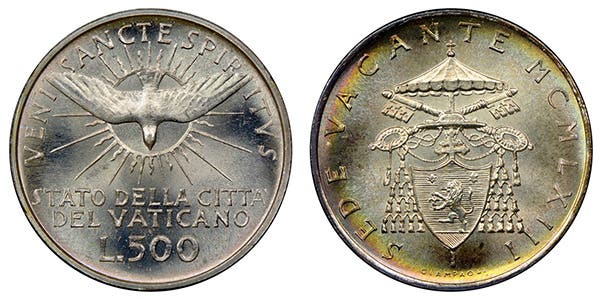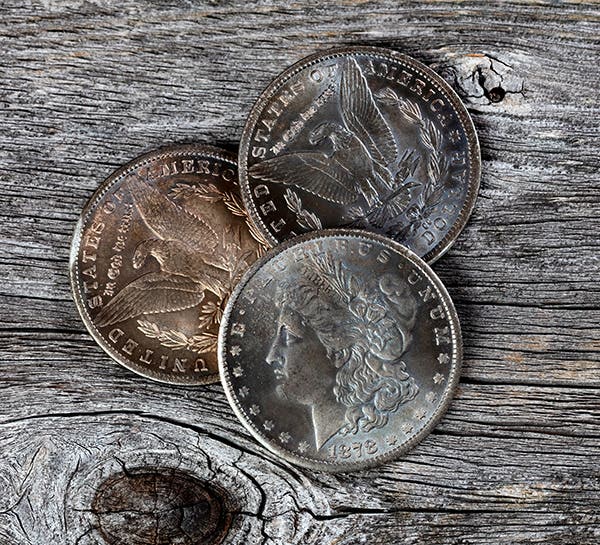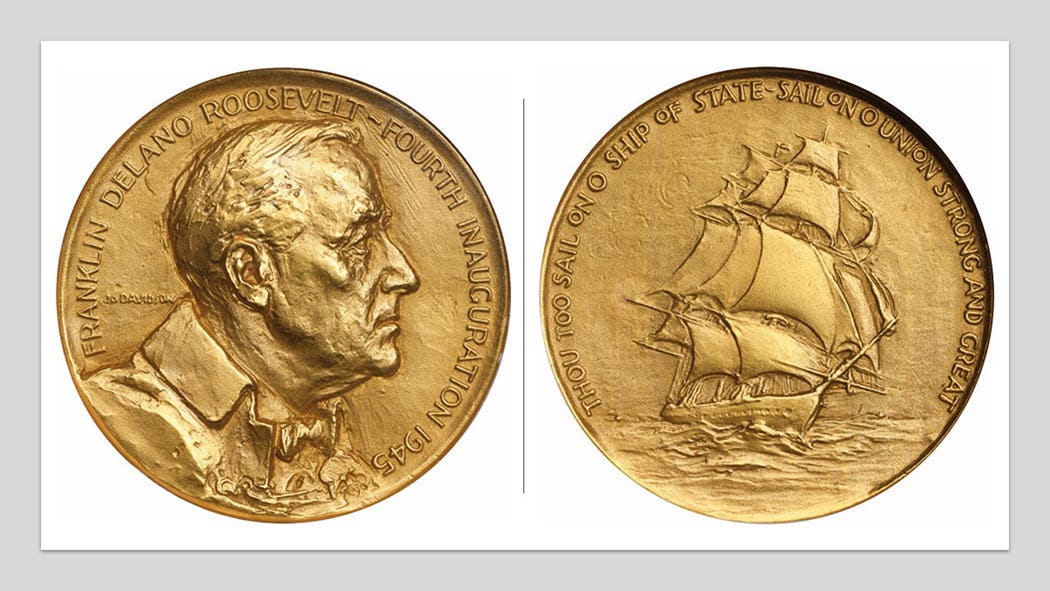Collecting Lincoln Memorial Cents
With such huge mintages, the vast majority of Lincoln Memorial cents are worth little more than face value, but there are several interesting die varieties and anomalies are bound to surface.
I started collecting coins in the mid 1950s, and like most collectors, then and now, I was hooked on Lincoln cents. At the time, all the Lincolns I encountered had wheat stalks on the reverse, or "Wheaties," in other words.
The end to new Wheaties came with the 1958 cent, replaced by 1959 cents with a representation of the Lincoln Memorial on their reverses. 1959 was an auspicious year for me, as that's when I graduated from high school.
Of course, the year was also the 50th anniversary of the Lincoln cent, which had begun in 1909, with Victor D. Brenner's design; 1909 wasn't just chosen at random, as it was the 100th anniversary of Abraham Lincoln's birth on February 12, 1809. Obviously, that would make 1959 the 150th anniversary or sesquicentennial of Lincoln's birth.
Frank Gasparro, an assistant to Chief Engraver Gilroy Roberts, submitted the design chosen for the memorial reverse. Gasparro's design depictes a front view of the Lincoln Memorial in Washington, DC, complete with the Lincoln statue visible in the center of the building. The designer's initials, FG, are located in the field to the right of the building.
With Roberts' departure to more lucrative fields (chairman of the board of the General Numismatic Corporation, which morphed into the Franklin Mint), Gasparro was appointed to the vacated position. Q. David Bowers, writing about Gasparro in A Guide Book of Lincoln Cents, offered the following description: "More than any chief engraver up to that time, Gasparro was a warm, friendly, outgoing man who loved numismatics and enjoyed meeting members of the coin collecting community. He was ever ready to relate his experiences and to grant interviews." He was widely mourned following his death in 2001.
One glance at a pricing guide such as "Market Watch" (MW) in this magazine will tell you that the vast majority of Lincoln Memorial cents are worth little more than face value. Mintages tell the story, as most are either well into nine figures or into the billions. To put these humongous mintages into perspective, the total mintage of Wheaties over their 50-year run was approximately 24.5 billion coins. By contrast, more than 27 billion Memorial cents were coined at the Philadelphia and Denver mints between 1964 and 1970!
That said, there's much interest in this 50-year series. With such huge mintages, anomalies are bound to surface, and, in fact, there are several interesting die varieties.
Die Varieties of Lincoln Cents
The first of these came in the second year of the new series: the 1960 small date cent. With a David Lange (The Complete Guide to Lincoln Cents) estimated mintage of a little more than two million, this variety was spotted early because it occurred in the first month of mintage, with the result that many were saved by numismatists. Although there was rampant speculation and outrageous prices were charged for the variety near the time of discovery, the value given for an MS60 in this magazine is just $2.75, with an MS65 worth $12.
1960s
According to Bowers, a quick way to tell if your 1960 cent has a large or small date is to examine the relationship between the date's first two digits: If the tops of the 1 and 9 are at the same level, it's the small date variety. Otherwise, it's the large date.
Another interesting and valuable 1960 cent variety is the small over large date proof 1960 cent. In Cherry Pickers' Guide to Rare Die Varieties of United States Coins by Bill Fivaz and J.T. Stanton (noted in this article as F/S), this is listed as a Doubled-Die Obverse, which Bowers called a large date over small date. No matter what it's called, MW says it's worth $600 in PR65.
The Denver mint was not immune from 1960 cent variety creation, and the most interesting variety is what F/S again called a Doubled-Die Obverse cent. Their description reads, "The doubling is evident as a Small Date Over Large Date. There is also a very wide[ly] repunched mintmark, with the secondary D far north of the primary D, actually touching the 9 of the date." MW values are $125 in MS60, $300 in MS65.
Variety gold struck again in 1969, with the 1969-S Doubled Die. As F/S described it, "Extreme[ly] strong doubling is evident on all obverse lettering and numbers." The mintmark is not doubled, however, and if someone offers you a strike doubling (also called machine doubling) version of the real thing, it's essentially worthless.
You wouldn't believe how many novice collectors think they've hit the jackpot when they find a 1969-S cent with strike doubling. When they show their find on CoinTalk, there's always an old hand on the site who gives a link to the real deal, putting an end to the finder's dreams of fortune.
Thinking the first examples reported were spurious, the Secret Service destroyed five of them before determining that they were actually genuine. The 1969-S Doubled Die is quite rare, with appropriately high MW values: $32,000 in MS60, $100,000 in MS65. Fivaz and Stanton noted that a PCGS MS65 RB example sold for $130,000 in 2008.
1970s
The 1970-S cent has its share of varieties as well. The small date versions are the ones of collector interest, both in the regularly issued coins and the proofs. According to F/S, "The easiest way to distinguish the Small Date cents of 1970-S is actually the word LIBERTY, which weakens dramatically from left to right." Bowers noted that in the date on the Small Date cents, the 7 is level with the top of the 0. It's also known as the 1970-S High 7 variety. MW values are $40 in MS60, $90 in MS65, and $60 in PR65.
Doubled die cents abound on the 1970-S Lincolns, with Lange reporting six. He wrote, "DDO-1 is quite pronounced and extremely rare, perhaps too rare to be considered collectable
. . . ." MW prices reflect this rarity, with values of $20,000 in MS65 and $15,000 in PR65. About the variety, Bowers noted, ". . . significant doubling is seen on the peripheral lettering. This issue. . . remains very rare, despite intensive searching through hoarded cents of this date."
F/S listed three doubled dies on the obverse of the 1971-S proof cent, with DDO-002 having the most pronounced doubling. Doubling is strongest on the motto and IN GOD WE TRUST, with none on the date. "This is by far one of the rarest Proof doubled dies in the Lincoln cent series. . . . .," they wrote. MW gives a value of $400 in PR65.
The next major variety is found on the 1972 cents, with pronounced doubling on the date, motto, and LIBERTY. There are several other doubled die obverse varieties of the 1972 cent, but DDO-001 commands the largest premiums. MW values are $285 in MS60 and $600 in MS65.
1980s
Next, we come to the 1983 cent with reverse doubling. Although there are several 1983s with obverse doubling, the 1983 with reverse doubling is the cream of the crop.
F/S described it as follows: "All reverse lettering is strongly doubled, including UNITED STATES OF AMERICA and ONE CENT. Also doubled are the designer's initials and portions of the memorial. . . . We suggest checking current price guides for constantly changing prices." The prices in MW are $180 in MS60 and $325 in MS65.
Next, we come to a variety I found in circulation (actually, in my wife's purse), had certified, and eventually sold, the 1984 Doubled-Die Obverse. It's also known as the 1984 Doubled Ear.
At some point in 1984, I read in a numismatic periodical about the new variety and that some had been found in a relatively nearby city in my state. After looking through all my saved cents and not finding it, I asked my wife if she had any pennies, she did, and the rest, as they say, is history. She had an example that was a nice, red, mint state coin. It was subsequently certified as MS64 Red.
Although Bowers wrote, "This variety can be discerned under low magnification and shows part of an extra earlobe below and slightly left of Lincoln's ear," I was able to see it clearly without magnification. Of course, you must realize that my eyes were 37 years younger than they are today!
My point is that the most interesting and expensive minting varieties are not so subtle that you need magnification to see them. Think 1955 Lincoln cent doubled die. Novice collectors frequently think they have found the 1984 Doubled Ear and send dramatic enlargements to CoinTalk. Unfortunately, their picture of the obverse of the coin doesn't show anything of the sort. Remember: If you can only see a minting variety at certain angles, in a particular light, and with 15X or greater magnification, forget it. It's either nonexistent or too subtle to be of much value.
Incidentally, I found it a lot harder to sell the 1984 Doubled Ear than I expected it to be. Most dealers I showed it to at a large ANA convention had no interest in it. When I took it to a dealer in die variety and error coins, he told me that there was a problem with zinc cents, that they sometimes developed what looked like tiny bubbles on the surface as the copper coating begins to separate from the zinc. Sure enough, when I looked at my coin with a loupe, I could see the tiny bubbles.
Armed with this knowledge, I became even more determined to get rid of mine. I offered it to a dealer I had done a lot of business with, told him what it was, and got an offer of $10. At the time, the wholesale value was maybe $200. I eventually got him up to $65, which I took.
1995
Although there are many additional die varieties among the Lincoln Memorial cents, including another doubled ear (1988), I'll close with the 1995 Doubled-Die Obverse. According to F/S, the coin has "Very strong doubling. . . evident on LIBERTY and IN GOD WE TRUST, with minor doubling on the date."
"First reported by Felix Dausilio, this variety received rapid recognition when it appeared on the front page of USA Today, sending all of us on a nationwide treasure hunt." I bought a certified example of this, kept it awhile, then sold it because I didn't think the actual doubling was nearly as dramatic as it appeared in photographic enlargements. Bowers appears to agree with my assessment, as he described the variety as ". . . slightly doubled on the obverse. . . ." MW gives values of $25 in MS60 and $60 in MS65, which is about what it was when I bought my example in 1995.
As I think you can see from my article, the 50-year Lincoln Memorial series has a great deal going for it for the average collector. For one thing, except for the varieties I've talked about (and many varieties I didn't talk about), it's a series with no real key dates or even scarce semi keys. Thus, it would be simple and relatively inexpensive to put together a really attractive set.
As for the minting varieties, doubled dies and the like, there are enough of these to whet the appetite of even the most jaded Lincoln cent collector. If you're interested in these, a good starting place for your search would be the most recent copy of the first volume of Fivaz's and Stanton's Cherry Pickers' Guide to Rare Die Varieties of United States Coins. The last edition (6th) was published by Whitman, and it appears on Amazon that a new edition is on the way. However, I found no listing for the book on the Whitman site.
At any rate, see if you can find a reasonably priced example of the 6th edition, and take it with you to the next coin show you attend. Happy Hunting!








